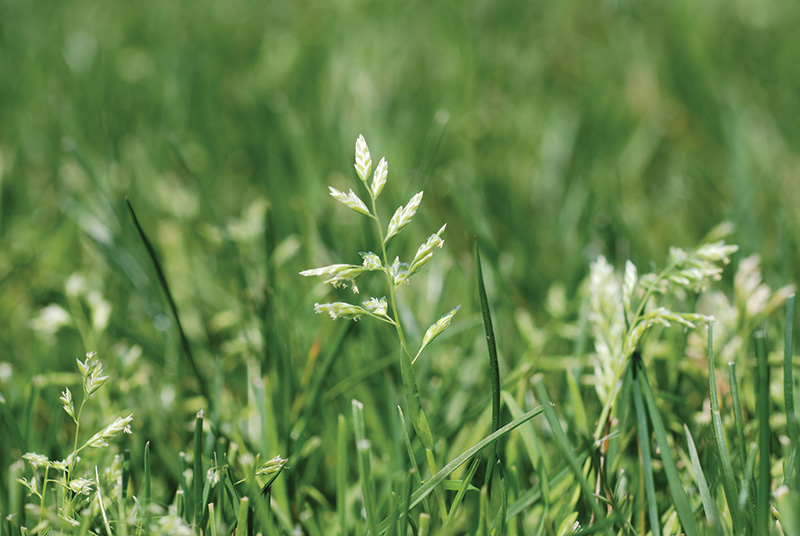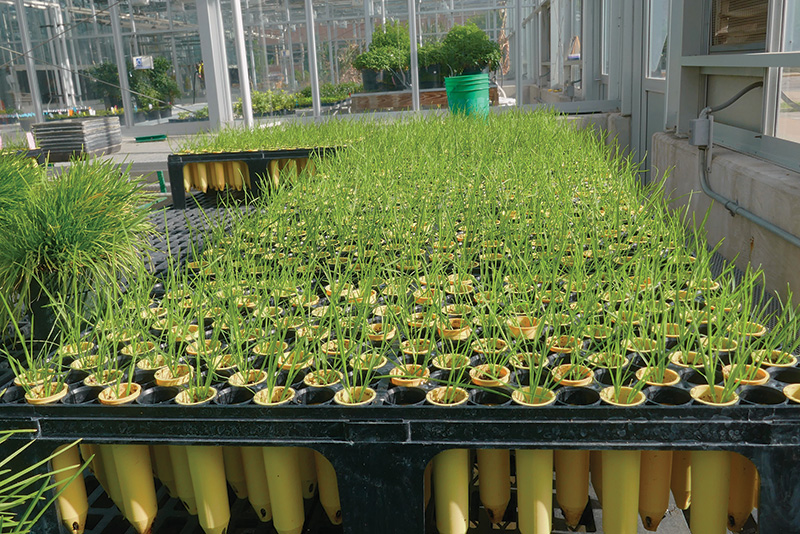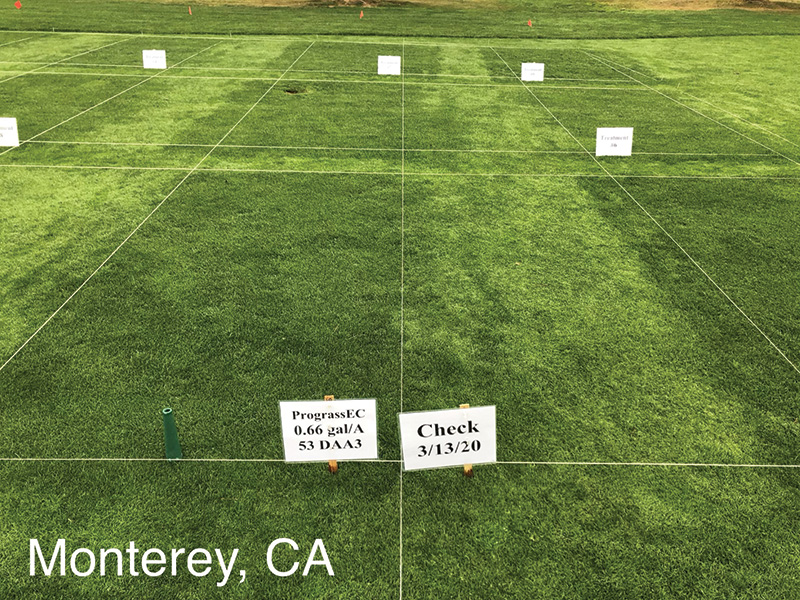
Figure 1. Annual bluegrass (Poa annua) can be identified by its distinct lime-green color and triangular seedhead.
Controlling annual bluegrass (Poa annua) (Figure 1) often requires repeated applications of herbicides with the same mode of action (MOA), which can lead to herbicide resistance. One of the most commonly applied herbicides for annual bluegrass control in cool-season turfgrass is ethofumesate (23). This herbicide can be used in cool-season grasses, including creeping bentgrass (Agrostis stolonifera), Kentucky bluegrass (Poa pratensis), perennial ryegrass (Lolium perenne) and tall fescue (Festuca arundinacea) in ornamental turf, lawns, parks, cemeteries and golf courses (2). This herbicide is most useful in perennial ryegrass turf, as it has excellent tolerance to this herbicide. Studies have documented only temporary, tolerable herbicide injury even when ethofumesate is applied above label rates to perennial ryegrass (4.5 and 8.9 pounds active ingredient per acre/5 and 10 kilograms per hectare) (8, 10, 11, 16). Kentucky bluegrass and tall fescue are more susceptible to ethofumesate injury than perennial ryegrass (11), which is why labeled rates are lower for these species (e.g., 0.75 pound active ingredient per acre/0.84 kilogram per hectare for Kentucky bluegrass) (2). Ethofumesate is also used to control annual bluegrass in dormant common bermudagrass (Cynodon dactylon) and dormant hybrid bermudagrass (C. dactylon × C. transvaalensis) fairways overseeded with perennial ryegrass (2, 9).
Repeated applications of herbicides with the same MOA are a primary reason for the development of herbicide-resistant weed populations (21). To date, there have been 49 reports of annual bluegrass resistance to herbicides with 12 MOA (14). One of the reports dates to 1994, when annual bluegrass resistance to ethofumesate was documented in grass seed production fields in Oregon (14). Recently, ethofumesate-resistant annual bluegrass populations were also reported in seed lots being tested prior to sale (25). However, it was not known if ethofumesate resistance also occurred on golf courses and what the magnitude of resistance might be. Therefore, the objective of this study was to determine the response of 30 annual bluegrass populations collected from golf courses in Alabama, California, Indiana and Oregon to ethofumesate.

Figure 2. An experiment to determine the response of 30 annual bluegrass (Poa annua) populations to ethofumesate was conducted at Purdue University in West Lafayette, Ind., in 2023.
Materials and methods
The experiment was initiated on Feb. 14, 2023, at Purdue University in West Lafayette, Ind. (Figure 2). In addition to seed from 30 annual bluegrass populations collected across the U.S., the study included two additional populations, one known to be susceptible to ethofumesate (ABG1903) and the other known to be resistant to ethofumesate (ABG1984). Each annual bluegrass plant was grown from seed in a cone-tainer (1 × 4 inches [2.54 × 10.16 centimeters], diameter × height) on a greenhouse bench (81/70 F [27/21 C] day/night, with 14-hour photoperiod). All cone-tainers were irrigated daily with municipal water. Liquid fertilizer (20% nitrogen-3% phosphorus-19% potassium) at 2,000 ppm was applied once every two weeks.
Ten doses of ethofumesate, 0, 0.5, 1.0, 2.5, 5.0, 7.5, 10, 15, 20 and 40 pounds active ingredient per acre (0, 0.56, 1.1, 2.8, 5.6, 8.4, 11.2, 16.8, 22.4 and 44.8 kilograms per hectare) were applied to plants two to three tillers in size. The herbicide used in this experiment was Prograss EC (Bayer Environmental Science, Research Triangle Park, N.C.) (1.5 pounds active ingredient per gallon/0.18 kilograms per liter). Applications were made using a compressed air track spray chamber calibrated to deliver a spray volume of 2 gallons per 1,000 square feet (814.92 liters per hectare) at 30 pounds per square inch using an 8004 even flat fan nozzle. All data were taken 28 days after treatment (DAT). Herbicide control was visually estimated on a scale of 0 (no injury) to 100% (complete death). The number of panicles on each annual bluegrass plant was recorded to estimate the reproductive potential after ethofumesate exposure of the examined populations. A digital image of each plant was taken using a camera and analyzed for green cover. Biomass was dried in an air-forced drier at 140 F (60 C) for three days, then weighed.

Table 1. Summary of annual bluegrass (Poa annua) resistance to ethofumesate by state tested.
Results
The effective dose necessary to kill 50% of the population (ED50) is a parameter often used in science, as it precisely compares the potency of herbicides. Therefore, the ED50 of the known susceptible and resistant annual bluegrass populations was used as baseline to determine the level of resistance for the 30 annual bluegrass populations examined in this study from U.S. golf courses. The mean and maximum ED50 value, level of resistance and frequency of flowering at ≥2.5 pounds active ingredient per acre are shown in Table 1 for each population.
Resistant populations were found on golf courses from all states where samples were taken; however, there were significant differences in the level of resistance between states (Table 1). The mean ED50 was 5.1, 3.5 and 3.4 pounds active ingredient (5.7, 3.9 and 3.8 kilograms per hectare) for populations originating from Alabama, Indiana and Oregon, respectively, while the mean ED50 for populations originating from California was significantly higher (9.2 pounds active ingredient per acre/10.3 kilograms per hectare) (P<0.0001), as shown in Figure 3.
The level of resistance in this research is expressed as R/S ratio. This ratio indicates how much more herbicide is needed to control the resistant population compared to the susceptible population. The mean R/S ratio of 4.3 for populations originating from California was higher (P<0.0001) than for populations originating from other states (2.4, 1.6 and 1.6 for Alabama, Indiana and Oregon, respectively). A higher magnitude of resistance in California populations is likely a consequence of historical management practices in this state. All California sites had warm-season grasses, such as bermudagrass, overseeded with perennial ryegrass to provide optimal green turf color and playing conditions during the winter months (7). Only a few herbicides are registered for annual bluegrass control in the polyculture of dormant bermudagrass and perennial ryegrass, with ethofumesate being one of them. Frequent use of ethofumesate in this system at these locations potentially led to the higher selection of resistant annual bluegrass plants (18).
Despite observing a low level of resistance, the findings of this study present a potentially concerning issue. Low and medium levels of resistance often indicate metabolism-based (non-target-site resistance (NTSR)) (13). This type of resistance mechanism minimizes the amount of active herbicide reaching the site of action inside plant tissues (28), by reducing herbicide uptake and/or translocation, increasing herbicide metabolism or decreasing the rate of herbicide activation (15).

Figure 3. Mean dose-response curves across tested annual bluegrass (Poa annua) populations from Alabama (AL), California (CA), Indiana (IN), and Oregon (OR) demonstrating that California populations tested had developed resistance to ethofumesate.
The majority of the annual bluegrass resistance cases are reported from locations with warmer climates, suggesting that there could also be an environmental relationship between annual bluegrass resistant populations. Previous research demonstrated partial heritability of changes that occurred within a plant due to abiotic stress (5). However, future research should examine if annual bluegrass populations from different environments are more prone to the development of herbicide resistance or if the increased occurrence of resistance at some locations is simply due to more herbicide selection pressure (more frequent use of that herbicide mode of action).
The level of cross-pollination in annual bluegrass has traditionally been considered low (up to 15%) (12); however, it is estimated that in some ecosystems with high annual bluegrass densities, the level of outcrossing can be up to 29% (19). This means that sites with more annual bluegrass plants, and a high genetic diversity of plants, have a greater risk for the development of herbicide resistance following repeated applications (5,6, 19).
We examined the Poa annua plants for flowering 28 days after treatment. This was approximately 54 days after germination. By that date, 40% of the populations produced seedheads after receiving an ethofumesate dose of ≥2.5 pounds active ingredient per acre (just above the labeled rate for Poa annua control). Additionally, the known resistant population from California had high fecundity and produced panicles even when the highest experimental rate of 40 pounds active ingredient per acre (44.8 kilograms per hectare) was applied. This data on seedhead development demonstrated that resistant populations not only survived the ethofumesate application, but that many were able to produce seed within just a few weeks following the herbicide application.
The ED50 for the known susceptible population (1903) in this study was 2.1 pounds active ingredient per acre (2.4 kilograms per hectare), which is slightly higher than the highest single labeled application rate of ethofumesate for perennial ryegrass (2.0 pounds active ingredient per acre/2.2 kilograms per hectare). This suggests that a single application of ethofumesate at 2.0 pounds active ingredient per acre was not effective in controlling our susceptible population. However, our study looked at only a single application of ethofumesate. Sequential ethofumesate applications in the autumn are shown in previous studies to be the most effective in controlling annual bluegrass (22) (Figure 4) and are recommended by the product label (2). Further, environmental stress and plant competition in the field allows for better annual bluegrass control with ethofumesate, with wintertime conditions helping to improve control following applications (26, 27).
The confirmed cases of ethofumesate resistance on golf courses presented here provide valuable information and will hopefully help golf course superintendents stay better informed about the risks of using certain herbicides for annual bluegrass control. As noted by McCurdy et. al., the management of herbicide resistance in annual bluegrass is a serious problem requiring a site-specific plan of action (17). Golf course superintendents are encouraged to develop and implement integrated weed management (IWM) practices with the goal of slowing down the selection of resistant plants (17).
Integrated programs should include diverse control tactics that may include use of certified, weed-free seed for establishment and overseeding. This is especially important as annual bluegrass seed resistant to ethofumesate has been found during the testing of seed prepared for retail distribution in the U.S. (25). Even though herbicide options are limited, the use of herbicides with different MOA is critical. In addition to ethofumesate, amicarbazone (Inhibition of Photosynthesis at Photosystem II; WSSA Group 5) (4), mesotrione (Inhibitor of Hydroxyphenyl Pyruvate Dioxygenase; WSSA Group 27) (3), and methiozolin (Inhibition of Fatty Acid Thioesterase, WSSA Group 30) (1) are labeled options for postemergence annual bluegrass control on bermudagrass golf courses with a perennial ryegrass overseeding program (4). Additionally, preemergence herbicides can significantly lower the annual bluegrass encroachment when overseeding bermudagrass with perennial ryegrass; however, timing must be impeccable at annual bluegrass germination, but before overseeding (24).
Alternatively, perennial ryegrass overseeding could be skipped and substituted with painting (20) to allow for the use of additional herbicide sites of action and the reduction of the annual bluegrass seedbank in locations with ethofumesate resistance. Additional research on the effectiveness of different IWM practices is needed at sites with resistance as well as an examination of potential cross resistance among ethofumesate-resistant annual bluegrass populations.

Figure 4. Perennial ryegrass (Lolium perenne) fairway turf after three applications of Prograss EC (left) to control ethofumesate susceptible annual bluegrass (Poa annua) seen in the check plot (right). The study was conducted by Mark Mahady at Monterey, Calif., in 2019. Photo by James Hempfling
The research says
- The existence of low-level ethofumesateresistant annual bluegrass has been confirmed.
- Sites with the highest resistance had a history of perennial ryegrass overseeding and ethofumesate use.
- The management of herbicide resistance in annual bluegrass is a serious problem requiring a site-specific plan of action. Golf course superintendents are encouraged to develop and implement integrated weed management (IWM) practices with the goal of slowing down the selection of resistant plants.
- Annual bluegrass can evolve enough ethofumesate resistance to survive labeled application rates and set seed, even though sequential applications are typical.
Acknowledgements
We thank Lauren Harmon, Mark Mahady, James Hempfling, Bruce Spesard and Devon Carroll for the assistance with this project.
Funding
This project was funded by the USDA-NIFA Specialty Crops Research Initiative (SCRI) program (award No. 2018-51181-28436).
Literature cited
- Anonymous. 2021. Poa Cure herbicide. Moghu Research Center, Yuseing, Daejeon, South Korea. Accessed Nov. 21, 2023. (https://cdn.shopify.com/s/files/1/0261/1065/6583/files/Label_PoaCure_SC_2021.pdf?v=1627359).
- Anonymous. 2018. Prograss EC herbicide. Bayer Environmental Science, Research Triangle Park, N.C. Accessed Nov. 28, 2023. (https://s3.amazonaws.com/aws.tirmsdev.com/web/692/1539/692_1539_LABEL_English_2018_.pdf).
- Anonymous. 2022. Tenacity herbicide. Syngenta Crop Protection, Greensboro, N.C. Accessed Nov. 21, 2023. (https://www.greencastonline.com/current-label/tenacity).
- Anonymous. 2020. Xonerate herbicide. FMC, Philadelphia. Accessed Nov. 21, 2023. (https://gss.fmc.com/us/sites/default/files/2022-05/Xonerate%202SC%2002-24-20%20Comm.pdf).
- Benson, C.W., Q. Mao and D.R. Huff. 2020. Global DNA methylation predicts epigenetic reprogramming and transgenerational plasticity in Poa annua L. Crop Science 61(5):3011-3022 (https://doi.org/10.1002/csc2.20337).
- Bertrand, A., Y. Castonguay, J. Cloutier, L. Couture, T. Hsiang, J. Dionne and S. Laberge. 2009. Genetic diversity for pink snow mold resistance in greens-type annual bluegrass. Crop Science 49(2):589-599 (https://doi.org/10.2135/cropsci2008.06.0303).
- Christians, N.E., A.J. Patton and Q.D. Law. 2017. Fundamentals of Turfgrass Management (fifth edition). John Wiley & Sons Inc., Hoboken, N.J.
- Coats, G.E., and J.V. Krans. 1986. Evaluation of ethofumesate for annual bluegrass (Poa annua) and turfgrass tolerance. Weed Science 34(6):930-935 (https://doi.org/10.1017/S0043174500068120).
- Cross R.B., L.B. McCarty, A.G. Estes, J.L. Sharp and J.E. Toler. 2012. Annual bluegrass control in overseeded golf course fairways when mitosis-inhibiting herbicides are not effective. Applied Turfgrass Science 9(1):1-9 (https://doi.org/10.1094/ATS-2012-0523-01-RS).
- Dean, M.R., J.H. Ollerenshaw and W.S. Stewart. 1987. The influence of ethofumesate on the growth and development, chlorophyll and nitrogen content of Lolium perenne L. Grass and Forage Science 42(3):225-232 (https://doi.org/10.1111/j.1365-2494.1987.tb02110.x).
- Dernoeden, P.H., and T.R. Turner. 1988. Annual bluegrass control and tolerance of Kentucky bluegrass and perennial ryegrass to ethofumesate. HortScience 23(3):565-567 (https://doi.org/10.21273/HORTSCI.23.3.565).
- Ellis, W.M. 1973. The breeding system and variation in populations of Poa annua L. Evolution 27(4):656-656 (https://doi.org/10.2307/2407198).
- Gaines, T.A., S.O. Duke, S. Morran, C.A.G. Rigon, P.J. Tranel, A. Küpper and F.E. Dayan. 2020. Mechanisms of evolved herbicide resistance. Journal of Biological Chemistry, 295:10307–10330. (https://doi.org/10.1074/jbc.REV120.013572).
- Heap, I.M. 2023. International survey of herbicide resistant weeds. (http://www.weedscience.org). Accessed: Sept. 20, 2023.
- Jugulam, M., and C. Shyam. 2019. Non-target-site resistance to herbicides: Recent developments. Plants 8(10):417 (https://doi.org/10.3390/plants8100417).
- Jukes, A.M., and P.M. Goode. 1981. Observations on the effect of post-emergence application of ethofumesate on the shoot growth of Poa annua and Lolium perenne seedlings. Grass and Forage Science 36(3):231-235 (https://doi.org/10.1111/j.1365-2494.1981.tb01560.x).
- McCurdy, J.D., R.G. Bowling, E.B. de Castro, A.J. Patton, A.R. Kowalewski, C.M. Mattox, et.al. 2023. Developing and implementing a sustainable, integrated weed management program for herbicide-resistant Poa annua in turfgrass. Crop, Forage & Turfgrass Management 9:e20225 (https://doi.org/10.1002/cft2.20225).
- McElroy, J.S., G.K. Breeden and G. Wehtje. 2011. Evaluation of annual bluegrass control programs for bermudagrass turf overseeded with perennial ryegrass. Weed Technology 25(1):58-63 (https://doi.org/10.1614/WT-D-10-00050.1).
- Mengistu, L.W. 1999. Genetic diversity and herbicide resistance in annual bluegrass (Poa annua L.) [Doctoral dissertation, Oregon State University]. Oregon State University ProQuest Dissertations Publishing (https://www.proquest.com/dissertations-theses/genetic-diversity-herbicide-resistance-annual/docview/304536497/se-2?accountid=13360).
- Nascimento, M.V.L, P.L.F. Santos, J.V. Costa, J.T. Martins, R.L. Bôas and L.J.G. Godoy. 2020. Durability and concentration of organic colorant in the visual quality of Discovery bermudagrass. Ornamental Horticulture 26:621-632 (https://doi.org/10.1590/2447-536X.v26i4.2211).
- Norsworthy, J.K., S.M. Ward, D.R. Shaw, R.S. Llewellyn, R.L. Nichols, T.M. Webster, K.W. Bradley, G. Frisvold, S.B. Powles, N.R. Burgos, W.W. Witt and M. Barrett. 2012. Reducing the risks of herbicide resistance: Best management practices and recommendations. Weed Science 60(SP1):31-62 (https://doi.org/10.1614/WS-D-11-00155.1).
- Park, B.S., M.T. Elmore and J.A. Murphy. 2019. Using herbicides and perennial ryegrass to renovate turf dominated by annual bluegrass. Crop, Forage & Turfgrass Management 5(1):1-7 (https://doi.org/10.2134/cftm2019.01.0005).
- Patton, A.J., M.T. Elmore, J. Kao-Kniffin, B. Branham, N. Christians, A. Thoms, S. Keeley, T. Nikolai, E. Watkins, X. Xiong, R. Gaussoin, M. Carroll, D. Li, D. Gardner, P. Landschoot, D. Soldat and P. Koch. 2023. Turfgrass weed control for professionals. Purdue University Extension Publication.
- Shaner, D.L., and K. Umeda. 2011. How rapidly do fall-applied prodiamine and dithiopyr disperse in established bermudagrass turf in southwest United States? Applied Turfgrass Science 8(1):1-7 (https://doi.org/10.1094/ATS-2011-0207-01-RS).
- Vukovic, V., C.M. Mattox, A.R. Kowalewski, B.C. McNally, C.A. Bigelow, S.L. Meyers, J.T. Brosnan and A.J. Patton. 2023. Ethofumesate-resistant annual bluegrass (Poa annua) in grass seed production systems. Weed Technology (in press) (https://doi.org/10.1017/wet.2023.68).
- Wang, Y., M. Wang, Y. Sun, Y. Wang, T. Li, G. Chai, W. Jiang, L. Shan, C. Li, E. Xiao and Z. Wang. 2014. FAR5, a fatty acyl-coenzyme A reductase, is involved in primary alcohol biosynthesis of the leaf blade cuticular wax in wheat (Triticum aestivum L.). Journal of Experimental Botany 66(5):1165-1178 (https://doi.org/10.1093/jxb/eru457).
- Woosley, P.B., D.W. Williams and A.J. Powell. 2003. Postemergence control of annual bluegrass (Poa annua spp. reptans) in creeping bentgrass (Agrostis stolonifera) turf. Weed Technology 17(4):770-776 (https://doi.org/10.1614/WT02-153).
- Yu, Q., and S. Powles. 2014. Metabolism-based herbicide resistance and cross-resistance in crop weeds: A threat to herbicide sustainability and global crop production. Plant Physiology 166(3):1106-1118 (https://doi.org/10.1104/pp.114.242750).
Vera Vukovic is a graduate student at Purdue University, in West Lafayette, Ind.; Clint M. Mattox, Ph.D., is a research weed scientist at USDA in Corvallis, Ore.; Alec R. Kowalewski, Ph.D., is a professor at Oregon State University, in Corvallis; Brandon C. McNally is a research associate at Purdue University; J. Scott McElroy, Ph.D., is a professor at Auburn University in Auburn, Alabama; and Aaron J. Patton, Ph.D., is a professor at Purdue University.